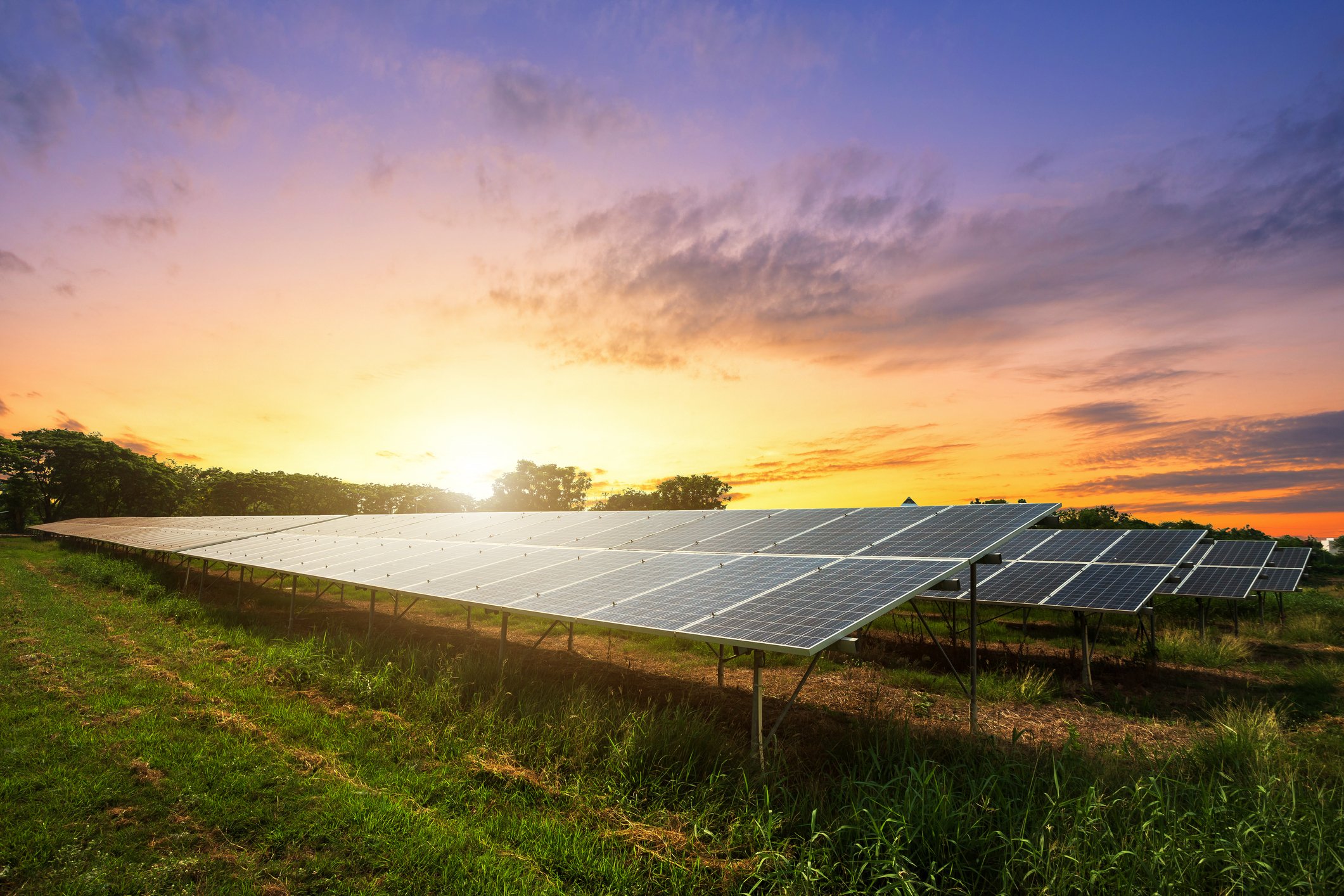Pattern Energy (PEGI +0.00%), perhaps my favorite high-yield renewable energy investment over the past couple of years, is going private. The company has accepted a cash deal worth $26.75 per share to be acquired by a large Canadian pension fund.
For many shareholders -- yours truly included -- this comes as a disappointment. I've been impressed with the company's results, and CEO Mike Garland's ability to navigate the market and make smart capital-allocation moves had me looking forward to a profitable decade to come. But all things come to an end, and unfortunately this one is just happening sooner than I'd hoped.

Image source: Getty Images.
Whether you're a Pattern shareholder or were considering buying Pattern, now it's time to identify another high-yield yieldco to invest in. Brookfield Renewable Partners (BEP +0.26%), its subsidiary TerraForm Power (TERP +0.00%), and NextEra Energy Partners (NEP 0.10%) look worthy of buying today. Clearway Energy (CWEN 1.05%) (NYSE: CWEN-A) and Atlantica Yield (AY +0.00%) are worth putting on your watch list.
Keep reading to learn more about these five alternatives to Pattern Energy.
Stocks to buy instead
1. Brookfield Renewable Partners
One of the oldest renewable-energy-focused high-yield investments out there, Brookfield Renewable's legacy is owning and operating hydroelectric power plants. Hydroelectric power is by far the most well-established source of renewable electricity, dating back more than a century, and capable of generating strong cash flow and returns.
Brookfield Renewable still counts on hydro for the majority of its business. Through the first half of 2019, 75% of its assets were hydro, with wind and solar making up the balance. Since going public about a decade ago, it has delivered exceptional returns, too:
BEP Total Return Price data by YCharts.
These returns are a product of a management team and corporate culture that prioritize long-term value creation, not short-term targets. Management allocates capital with a goal of delivering the best long-term returns and cash flow growth. And that's paid off, with funds from operations (FFO) and cash flow increasing 464% and 345% respectively since the company went public.
Investors looking to buy today would capture a 4.7% yield based on current prices and the most recent dividend. You could expect Brookfield Renewable to continue growing the dividend. The company targets are total annualized returns of 12% to 15% on average, with 5 to 9 percentage points of that from dividend growth.
2. TerraForm Power
The TerraForm Power story is heavily tied to Brookfield Renewable, following the 2017 acquisition of a controlling stake in the company by Brookfield Renewable and its corporate parent, Brookfield Asset Management, and a second investment in 2018. Brookfield Renewable directly owns 30% of TerraForm Power, and Brookfield Renewable and its institutional partners together own 65%.
Today, TerraForm Power follows the Brookfield playbook for capital allocation and operations. That's resulted in massive improvements in the company's financial profile, while the cash infusion from Brookfield has helped fund some game-changing acquisitions that have delivered enormous growth in TerraForm Power's cash flow.
The result? Gigantic returns for investors since becoming part of the Brookfield family:
Yes, two-thirds of those returns have gone to Brookfield and its partnered entities. But the 35% of TerraForm Power that's available to the rest of us continues to make for an excellent investment. Investors today can capture a 4.8% yield at recent prices, and potentially experience a higher rate of return than Brookfield Renewable, since that company continues to use TerraForm Power to drive a lot of its own growth.
3. NextEra Energy Partners
Smaller than Brookfield Renewable and TerraForm Power, NextEra Energy Partners also pays the smallest yield -- 3.9% at recent prices. It's also controlled by NextEra Energy, one of the largest power utilities in the world, and most of its acquisitions are tied to that company's renewable-energy project development.
In other words, NextEra Energy Partners tends to fish from a smaller pond than our two erstwhile yieldcos, which are truly global players in utility-scale power generation. But what it may lack in global reach and current yield, it more than makes up for in opportunity for outsize growth.
NextEra Energy is one of the biggest developers of utility-scale wind and solar projects in the world, and NextEra Energy Partners functions as a "dropdown" entity, acquiring assets from its parent and then monetizing them by operating them and selling the power they produce. NextEra Energy benefits by reducing the amount of debt it carries on its own balance sheet, while still enjoying a share of the cash flow through its stake in NextEra Energy Partners.
That's not the only source of high growth for NextEra Energy Partners. In addition to renewable-energy assets it buys from the mother ship, it has also invested heavily in natural gas pipelines, taking advantage of growing demand to get more natural gas into more parts of the U.S., particularly to meet the needs of power producers moving away from coal.
Early investors in this master limited partnership have nearly doubled their investment since it went public about five years ago. A big part of those gains is the product of an aggressive plan to return cash to investors. The dividend has been increased almost 180% already, and management expects to continue growing the payout at a double-digit rate.
Two more for your watch list
1. Atlantica Yield
Originally a spinoff of Spanish energy and infrastructure company Abengoa SA, Atlantica Yield now calls Canadian power and utility giant Algonquin Power & Utilities Corp. its largest shareholder. In 2018, Algonquin acquired shares worth 41.5% of Atlantica from Abengoa, and now owns over 44% of the company.
Algonquin and Abengoa also formed a joint venture -- named AAGES -- to develop and construct clean energy and water infrastructure assets, with Atlantica to have right of first offer to buy these assets after they are developed. Atlantica also has an agreement with Algonquin to purchase and collaboratively invest in assets developed by Algonquin, independent of the AAGES joint venture. Between the AAGES venture and Algonquin's separate asset development, Atlantica has a substantial pipeline of assets in wind, solar, and water infrastructure to acquire to drive future growth.
Why not call it a "buy now" yieldco? In short, I'm not convinced that Algonquin is fully committed to developing assets. If it decides to step away from this business and focus more on its regulated utility holdings, it would likely divest its stake in Atlantica Yield, and depending on the acquirer, it's impossible to know what would happen.
Simply put, there's too much uncertainty for an investment that should be a little more predictable. I want to be a little more certain Algonquin is committed as a developer before risking capital in Atlantica Yield.
2. Clearway Energy
Yet another yieldco that's seen its corporate parentage change hands, Clearway Energy was formerly known as NRG Yield. NRG Energy sold its stake in NRG Yield and all its renewable energy assets to privately held Global Infrastructure Partners in August 2018. Global Infrastructure Partners combined NRG Yield and NRG's renewable assets into a single entity, renaming it Clearway Energy.
On one hand, it might look like this has been a bad combination. Since becoming Clearway Energy, the company has slashed the dividend by 40%; shares have barely managed to break even, and only after accounting for dividend payments. Other yieldcos have delivered strong returns over the same period:
CWEN Total Return Price data by YCharts.
So what gives? Clearway has substantial exposure to the ongoing PG&E bankruptcy, with millions in distributions owed to it that can't be released. That's the big reason behind the dividend cut, and the main thing that's held its stock price back while other yieldco stocks have done well.
So why is it on this list? Because if and when it moves beyond the ongoing PG&E saga, I expect it to collect nearly all of the cash it is owed, and for it to realize the full economic potential of those assets.
But as with Atlantica, the lack of certainty -- in this case due to its biggest customer, not its biggest shareholder -- keeps me from pulling the trigger. That's even with a 4.2% yield that's now secure, and the likelihood that it will eventually be made whole -- or close to it -- once the mess that is PG&E is resolved.












